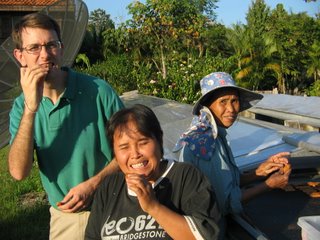

Several years ago, as part of a drive to improve the Thai economy at the local (village) level, the OTOP program was started. OTOP stands for "One Tambon, One Product," a tambon being a unit of local government approximately equal to a township. Every tambon has the opportunity to specialize in one or more products, and these locally-made products, when approved, will have a special label on their packaging marking them as OTOP. They can also be rated with a certain number of stars (1 to 5) indicating their quality. Examples of OTOPs in our area include cloth weaving, banana chips, and sweetened rice cakes. OTOPs I have seen from other parts of the country include dried mushrooms, wood carving, silk weaving, and all sorts of sweets and snacks.
After our school visit to a village north of town yesterday, we were taken by Pi Nongnut – a very enthusiastic woman who is part of that area’s governing council – to visit the local OTOP makers. We were taken to a lovely piece of property with a very large and beautiful traditional northern Thai house. Outside the house were two long tables covered in plastic. Looking under the plastic, we were able to see rows of "sweet water" bananas (a popular variety) drying in the warm sun, protected from bugs. We also went inside the packing building, where Pi Nongnut showed off the clean facilities and machines for sealing the bananas in plastic packaging.
Not only did we get to taste several of the delicious bananas fresh from the drying tables, but we were given ten boxes to take home with us! Our refrigerator is now very, very full.
After our school visit to a village north of town yesterday, we were taken by Pi Nongnut – a very enthusiastic woman who is part of that area’s governing council – to visit the local OTOP makers. We were taken to a lovely piece of property with a very large and beautiful traditional northern Thai house. Outside the house were two long tables covered in plastic. Looking under the plastic, we were able to see rows of "sweet water" bananas (a popular variety) drying in the warm sun, protected from bugs. We also went inside the packing building, where Pi Nongnut showed off the clean facilities and machines for sealing the bananas in plastic packaging.
Not only did we get to taste several of the delicious bananas fresh from the drying tables, but we were given ten boxes to take home with us! Our refrigerator is now very, very full.
2 comments:
I'm as big a banana fan as anyone else I know, is there not something a little weird about needing put dried bananas in the fridge, especially since fresh bananas are available all year round? Or is that a bonus: "hey, normal bananas don't do well in the fridge, but these fancy dried bananas can!"
I do now remember some mighty tasty dried bananas in Phetchaburi that were not dried to banana chip hardness and probably would have needed refrigeration had we not eaten them quickly. I think they had something like sweetened, condensed milk poured over them. Yum.
These particular dried bananas are extraordinarily soft and sweet, though Pi Nongnut assured us multiple times that there was nothing added to them.
We put them in the refrigerator primarily to keep them safe from ants. The ants in our house are crazy and will eat nearly anything we leave out... including anything even remotely sweet! They even eat herbal tea.
Post a Comment